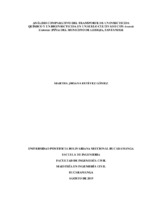Mostrar el registro sencillo del ítem
Análisis comparativo del transporte de un insecticida químico y un bioinsecticida en un suelo cultivado con ananás comosus (piña) del municipio de Lebrija, Santander
| dc.contributor.advisor | Director. Pineda Vargas, Sergio Manuel | |
| dc.contributor.author | Estévez Gómez, Martha Jhoana | |
| dc.coverage.temporal | 2019 | |
| dc.date.accessioned | 2021-05-18T15:05:30Z | |
| dc.date.available | 2021-05-18T15:05:30Z | |
| dc.date.issued | 2019-11 | |
| dc.identifier.uri | http://hdl.handle.net/20.500.11912/8547 | |
| dc.description | 94p.: (pdf); il; imágenes; gráficas; tablas; anexos. | spa |
| dc.description.abstract | Este estudio presenta el análisis del transporte del insecticida químico Lorsban y un bioinsecticida a base de nicotina y capsaicina, aplicados en suelos cultivados con Ananás Comosus (Piña) en el Municipio de Lebrija, Santander. Para este efecto se tuvo en cuenta las áreas denominadas: suelo blanco (SB), sin cultivo y sin fumigación; suelo control (SC), sembrado con piña, sin fumigación; suelo SFQ, con siembra y fumigación con el insecticida químico Lorsban; y el suelo SFB, con siembra y fumigado con el bioinsecticida. Los cuatro suelos presentaron inicialmente igual textura franca arcillo arenosa, bajo contenido orgánico y un pH entre 4,25 y 4,65. Sin embargo, durante los 8 meses de experimentación, la textura del suelo SC y SFQ cambió a Franco arenoso, mientras que el suelo SFB mantuvo su estructura inicial, que se podría atribuir a la agregación del bioinsecticida. De igual manera se destaca para el suelo SFB un efecto favorable del bioinsecticida en el comportamiento del pH. Por su parte, el suelo fumigado con el insecticida químico SFQ, demuestra señales de deterioro dado el cambio en la textura. Bajo las condiciones iniciales, el modelo de transporte utilizando Hydrus, indicó que el insecticida químico presenta una baja dispersión dada su alta capacidad de adsorción a la fracción coloidal del suelo, así como su moderada permeabilidad y alta biodegradación; sin embargo, cuando el suelo es sometido al uso del insecticida químico Lorsban, se presentan alteraciones en las propiedades fisicoquímicas que incrementan la capacidad de dispersión del contaminante, y con ello, cambios en los aptitudes del suelo. Contrario a esto, lo suelos tratados con el bioinsecticida no presentan cambios en la estructura, destacándose una baja posibilidad de ser lixiviado hacia el nivel freático debido a las partículas coloidales presentes que reducen la escorrentía superficial y la erosión, favoreciendo su retención para ser biodegradado. | spa |
| dc.description.abstract | This study presents the analysis of the transport of the chemical insecticide Lorsban and a bioinsecticide based on nicotine and capsaicin, applied in soils cultivated with Ananás Comosus (Piña) in the Municipality of Lebrija, Santander. For this effect, the so-called areas were considered: white soil (SB), without cultivation and without fumigation; control soil (SC), sown with pineapple, without fumigation; SFQ soil, with sowing and fumigation with the chemical insecticide Lorsban; and the SFB soil, sown and fumigated with the bioinsecticide. The four soils initially presented the same sandy clay loam texture, low organic content and a pH between 4.25 and 4.65. However, during the 8 months of experimentation, the texture of the SC and SFQ soil changed to sandy loam, while the SFB soil maintained its initial structure, which could be attributed to the aggregation of the bioinsecticide. Similarly, a favorable effect of the bioinsecticide on the pH behavior stands out for the SFB soil. For its part, the soil sprayed with the chemical insecticide SFQ, shows signs of deterioration given the change in texture. Under the initial conditions, the transport model using Hydrus, indicated that the chemical insecticide has a low dispersion given its high adsorption capacity to the colloidal fraction of the soil, as well as its moderate permeability and high biodegradation; however, when the soil is subjected to the use of the chemical insecticide Lorsban, there are alterations in the physicochemical properties that increase the dispersion capacity of the contaminant, and with it, changes in the soil\\\'s aptitudes. Contrary to this, the soils treated with the bioinsecticide do not present changes in the structure, highlighting a low possibility of being leached towards the water table due to the colloidal particles present that reduce surface runoff and erosion, favoring its retention to be biodegraded | eng |
| dc.format.mimetype | application/pdf | |
| dc.language.iso | spa | |
| dc.publisher | Universidad Pontificia Bolivariana | spa |
| dc.rights | Attribution-NonCommercial-NoDerivatives 4.0 International | * |
| dc.rights.uri | http://creativecommons.org/licenses/by-nc-nd/4.0/ | * |
| dc.subject | Sustancias peligrosas - Transporte | spa |
| dc.subject | Cultivos y suelos | spa |
| dc.subject | Piñas | spa |
| dc.subject | Lebrija (Santander, Colombia) | spa |
| dc.subject | Insecticidas | spa |
| dc.subject | Plaguicidas | spa |
| dc.title | Análisis comparativo del transporte de un insecticida químico y un bioinsecticida en un suelo cultivado con ananás comosus (piña) del municipio de Lebrija, Santander | spa |
| dc.type | Maestría | spa |
| dc.publisher.department | Escuela de Ingenierías | spa |
| dc.publisher.program | Maestría en Ingeniería Civil | spa |
| dc.type.hasVersion | publishedVersion | spa |
| dc.description.sectional | Bucaramanga | spa |
| dc.description.degreename | Magíster en Ingeniería Civil | spa |
Ficheros en el ítem
Este ítem aparece en la(s) siguiente(s) colección(ones)
-
Tesis de especialización, maestría y doctorado [1857]
Tesis de especialización, maestría y doctorado


